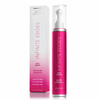
Haircut Regret: How to Avoid It (And What To Do If It’s Too Late)

It’s happened to everyone. Your stylist turns you around in the chair, and you hate what you see in the mirror – you have haircut regret.
With a few simple steps, you can avoid haircut regret and the pain of an awkward growing out phase.
Too late? Sporting a haircut you hate? No problem – we have steps for working around a bad styling sesh, too:
How to Avoid Haircut Regret
1. ASK FOR A CONSULTATION
Taking a chance on a brand new stylist is one of the most common ways people wind up with a hateable haircut.
When you call to set up an appointment with a new stylist, describe the kind of hair you have and ask to work with someone who has plenty of experience with your style and texture, suggests hairstylist Richard Mannah.
“If you’re specific enough with your hair type and your needs, they’ll think of someone who is experienced in say, curly hair or color, and pair you with them,” Mannah explained to InStyle.
Be sure to follow up with online reviews or ask friends about their experiences at a particular salon, too.
Nervous about sitting in the chair with someone new? A consultation can help you clarify what you’re looking for.
“The consultation is when we can see the hair texture when it’s dry, how you wear it, and when you can explain all of the little details of what you want done,” Mannah continued.
Use this time to make sure you and your new stylist are on the same page – and to come clean about your hair’s history.
“A client once told me her hair wasn’t chemically straightened, even though I specifically asked,” writes colorist Kyle White at Refinery29. “I used a strong bleach on what I thought was very coarse, heavy, thick, virgin hair. She had lied — and the ends of her hair melted off.”
Your new stylist won’t judge you for what you’ve done to your hair in the past – but they definitely need to know the whole story to make the right decision for you.

2. BRING A PICTURE
When it comes to describing hairstyles, words can only take you so far. Avoid hating your haircut by bringing a picture of the style you envision.
“With a visual, the stylist can provide expertise, like whether or not the hairstyle in question works with your face shape,” stylist Oscar Blandi told Glamour.
A photo is especially important if you’re trying to nail down a particular color, or you’re completely changing direction with your style to try something new.
Stylists may not be mind readers, but good ones will know what works well for your hair texture, shape, and color – a picture is just the starting point of the discussion!
3. TALK THE LOOK THROUGH
Not all hair textures will produce the kinds of styles you lust over in celeb magazine photos – but a good stylist will know what your texture is capable of.
“A lot of hairstylists don’t know how to deal with density or even texture,” hairstylist Jon Reyman warned Refinery29.
“Most hairdressers learn how to deal with length — the surface of the hair, the layers, and the perimeter — but they don’t know how to soften up the interior,” he added. “That’s a very specific skill.”
Your consultation is a great time to work out these first-time kinks.
Ask your new stylist to talk to you about the texture of your hair and their plan for the cut. A good stylist will be able to walk you through the whole thing before a strand is snipped.
4. SPEAK UP
As far as your new style goes, remember: you’re in the driver’s seat. If your stylist gets a gleam in her eye and starts making suggestions that sound way off base – speak up!
According to Reyman, a killer stylist should be able to help educate you about the decisions he or she is making.
“A client might say, ‘Don’t use a razor; that’s not good for my hair,’” Reyman explained to Refinery29. “Instead of just agreeing with them, a good hairstylist will ask what happened to them to make them think that’s not good. Then I can deduce if it was the technique or if that razor really didn’t work on their hair type.”
A back-and-forth with your stylist should help put you at ease and make you feel like you’re in capable hands.
What to Do If You Hate Your Haircut
1. WORK AROUND IT
Not all bad haircuts are created equal. With a bit of clever styling, you may be able to work around your cut until it grows in, or you have time to get used to your new ‘do.
“Incorporating chic hair accessories or exposed bobby pins into your style helps lessen the look of a cut gone wrong,” suggests Cosmopolitan beauty editor Carly Cardellino.
From hair clips and bobby pins to heated styling tools, play around to see what your new hair is capable of.
Playing around can also help you cope with a bad haircut and feel more comfortable with your new look.
2. TRY NEW PRODUCTS
One reason women wind up hating cuts? They aren’t prepared for how the new style changes their routine.
Whether you add in a new texturizing spray, play around with putty, or have to schedule an extra hour in the morning to futz with a flat iron, it may just be that this style requires more maintenance and upkeep than you were bargaining for.
If that’s the case – all it takes from here is time.
3. OPT FOR EXTENSIONS
If your haircut is truly awful and you can’t wait through the awkward growth phase you know is coming, extensions might be an option.
“Whether it’s clip-ins or a more permanent solution, if you find yourself feeling like you need a serious solution fast, you can cover up your true length while giving your locks time to grow,” advises Aly Walansky at StyleCaster.
4. GIVE IT TIME – BUT BE PROACTIVE
All new cuts take some getting used to – and there’s good reason.
Sometimes getting used to a new cut is really all about the waiting game, but it may be worth going back to the salon and voicing your unhappiness.
Be aware there’s an art to navigating this conversation, says stylist Devin Toth.
“Just like any other complaint, it always makes sense to have a positive dialogue that moves everyone forward towards a cut color that works,” Toth told Good Housekeeping.
“And be specific – if all you’re saying is that you dislike it, you aren’t giving your stylist any useful feedback to help you achieve your hair goals,” he added.
If you assume your stylist has good intentions, it’s easier to move forward, have a productive dialogue, and fix that cut for good.
Now that you know how to navigate your next styling sesh, hop into that seat without fear. The more you speak openly with your stylist about your hair’s history and what kind of style you’re after, the easier it will be to love your new ‘do.



















